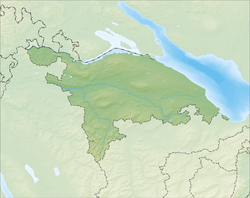Bischofszell
| Bischofszell | ||
|---|---|---|

Bischofszell
|
||
|
||
| Coordinates: 47°30′N 9°14′E / 47.500°N 9.233°ECoordinates: 47°30′N 9°14′E / 47.500°N 9.233°E | ||
| Country | Switzerland | |
| Canton | Thurgau | |
| District | Weinfelden | |
| Area | ||
| • Total | 11.62 km2 (4.49 sq mi) | |
| Elevation | 506 m (1,660 ft) | |
| Population (Dec 2015) | ||
| • Total | 5,895 | |
| • Density | 510/km2 (1,300/sq mi) | |
| Postal code | 9220 | |
| SFOS number | 4471 | |
| Surrounded by | Hauptwil-Gottshaus, Hohentannen, Kradolf-Schönenberg, Niederbüren (SG), Niederhelfenschwil (SG), Waldkirch (SG), Zihlschlacht-Sitterdorf | |
| Twin towns | Möhringen, Tuttlingen (Germany), Battaglia Terme (Italy), Waidhofen an der Ybbs (Austria) | |
| Website |
www SFSO statistics |
|
Bischofszell is a municipality in Weinfelden District in the canton of Thurgau in Switzerland. It is the seat of the district. In 1987, the city was awarded the Wakker Prize for the preservation of its architectural heritage. So was its neighboring city Hauptwil-Gottshaus in 1999.
A Bronze Age Tumulus, scattered Roman and Alamanni items and Early Middle Ages documents provide evidence of earlier settlements. It was probably founded in the 9th Century by the Bishop of Constance Salomo I. The current town of Bischofszell is first mentioned in 1155 as Bischoffescella. In 1250 it avoided being passed from the Bishop of Constance to the Prince-Abbot of St. Gall. In 1273 it was conquered the lords of Montfort, who burned the city. East of the castle a market and town grew up during the 13th Century. This new town around the market became the center of the modern city. The second enlargement began in 1360 when the noisy, smell or flammable businesses moved to the east of the town. Around 1405, this section was demolished for military reasons, and rebuilt, with a city wall, in 1437.
The town seal of 1338 (gloved arm with crozier) and the Charter of 1350 testify to the beginning of the municipal government. The financial difficulties of the Bishop encouraged the autonomy aspirations of citizens, who often bought city rights from the Bishop. Bischofszell remained mostly independent under the Bishops of Constance. Starting in 1276 the Bishop's Chief Bailiff resided in the castle. He was the chairman of the twelve-membered City Council. The bailiff, with two leading members of the council, formed the high court of the city between 1485 and 1798. The high and low courts were not identical. The City Court had the low justice rights in the city and surroundings, while after the conquest of Thurgau by the Swiss Confederation in 1460 the Governor had low justice rights in part of the city, and high justice rights over the Heiliggeistspitals.
...
Wikipedia




